California Break Laws: Employers Must Provide Employees With Meal and Rest Breaks

Non-exempt employees who work shifts of five hours or more must receive a 30-minute, uninterrupted meal period during their shift. If the shift is more than 10 hours, the employee is entitled to two 30-minute meal periods. During these meal breaks, the employee generally must be relieved of all duties. Hourly employees are usually required to “clock out” during meal breaks. While employers must, with few exceptions, make these meal periods available to their non-exempt employees, the employees do have the right to forego meal breaks during shifts of less than six hours.
If an employer does not allow an employee to take a meal break, that employee is entitled to a penalty of one hour of pay at his or her regular hourly wage. However, an employee and the employer may agree to waive the meal break requirement. The agreement, however, must be in writing, and the employee must have the right to revoke the agreement at any time.
California law also requires employers to have a policy that allows non-exempt employees to have regular rest breaks. For every four hours worked, employees are entitled to a 10-minute rest break. Employees who are prevented by the employer from taking a rest break are entitled to one hour of pay at their regular wage for each day they were denied one or more rest breaks.
California Break Laws FAQ
- What are my rights to meal breaks for a typical workday in California?
In California, as a non-exempt employee working over five hours, you’re entitled to a 30-minute meal break. If your workday exceeds 10 hours, you’re eligible for a second meal break. These breaks should be uninterrupted and free from work duties. - If I miss my meal break, am I eligible for any additional pay?
Yes, if your employer doesn’t provide the required meal break, you’re generally entitled to an extra hour’s pay at your regular rate for each day the meal break wasn’t provided. - How important is it for managers to monitor meal breaks?
It’s advisable for managers to ensure that employees are taking their meal breaks appropriately. This involves implementing and enforcing a clear meal break policy, and encouraging employees to adhere to it. - Are meal break rules different for remote or offsite employees?
While the basic rules remain the same, ensuring compliance for remote or offsite workers can be more challenging. Employers often need to communicate actively with these employees to make sure they’re taking their required breaks. - Can employees choose not to take meal breaks?
Employees can waive their meal breaks under certain conditions, like if their workday is six hours or shorter. It’s a good practice to have such waivers documented. - What about rest breaks in California?
For every four hours worked, non-exempt employees are entitled to a 10-minute paid rest break. These breaks should be uninterrupted and are generally scheduled in the middle of the work period. - Do all employees in California qualify for these meal and rest breaks?
The meal and rest break laws mainly apply to non-exempt employees. Those who are exempt, such as certain managerial, intellectual, or creative professionals, might not be eligible under the same terms. However, exceptions exist for specific job categories. - Can employers ask employees to work during their breaks?
Employers typically shouldn’t ask employees to work during meal or rest breaks. However, there are exceptions where “on-duty” meal breaks are permissible under certain work conditions, usually formalized through a written agreement.
The rules may seem confusing, but we can help you understand your rights. Call us now.
